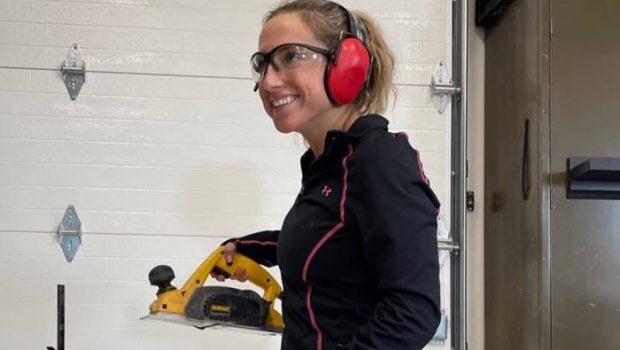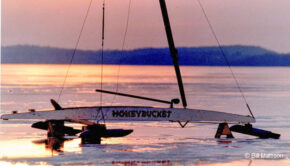Iceboating bug can be dangerous
Published on February 20th, 2021
The passion and persistence of iceboaters sets them apart. With the hours perfecting their boats and the miles driving to find good ice, it’s those few days of great sailing that keep them coming back. Catching the iceboating bug can be dangerous… just ask twenty-something year old Erin Bury:
Since the December 2020 Spaight St. Syndicate wrote about me, I bought my own iceboat (DN 5397) and sailed it on two occasions – the day I bought it and at the 2021 U.S. DN Nationals. At Nationals, it seemed like anything that could go wrong did go wrong – boom jaw broke off, outhaul on the boom that was loaned to me in the wake of the broken boom jaw disappeared mid-warmup (sorry Daniel), and I was catapulted from my DN in a 40 mph gust.
What I learned – my boom jaw was overtightened, things can shake loose on chunky ice, and how far a 109-pound human missile can fly when launched 30-40 mph. The launch was due to my plank being too stiff for my body weight and this would need to addressed in order for me to stay competitive (and in my boat).
It may be indelicate for a lady to discuss her weight, but in this sport, weight matters. (Plus, let’s be done with body shaming already.) In ice sailing, one can use her weight to her advantage. An ice sailor gets to tailor her boat to her body instead of tailoring her body to her boat. Imagine having precise input on how something fits you and you do not have to change anything about yourself to make it happen. Cue plank shaving!
Over the course of a weekend, Daniel Hearn (DN 5352, walking encyclopedia of all things sailing, ranked seventh internationally as of the 2020 Gold Cup, and a killer catamaran sailor) and Dave Shea (motorcycle number 426, engineer who races dirt bikes on the ice and motorcycles in the road race circuit) helped me customize the plank on my DN for my weight.
First, we measured how much it was bending under my weight, which was around 21 millimeters, while the ideal range is 42-44 millimeters (translation: I was having zero impact on it). We decided on an arc that could be described as “sexy” and began planing the plank.
After shaving off large chunks, we started sanding. Once we achieved the desired shape, it was time to set it in stone (or glass). Once the fiberglass was set, it was time to sand it again to remove stiffness and maintain that “sexy” shape. The goal is to have it ready in time for the Western Region Championship; thanks to Daniel and Dave this will be possible.
These are usual growing pains of buying a new toy and learning a new sport. When trying something new, I ask myself, “What would I do if I wasn’t afraid?” I’d get flung from my iceboat a hundred more times if it means I get to learn something.
I cannot wait to get out on the ice to see how my boat performs and what I am capable of with a new boom jaw, a secured outhaul, and a newly formed and customized plank. Anything worth doing will come with challenges and opportunities for growth. As my late grandma/best friend/inspiration (who was third in the world as an All-American triathlete) would say, “Live while you are alive.”










 We’ll keep your information safe.
We’ll keep your information safe.